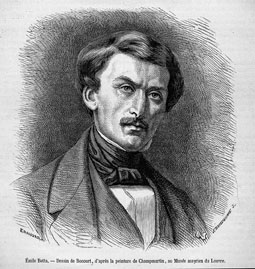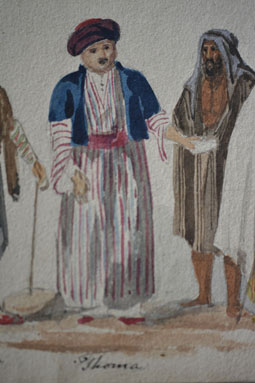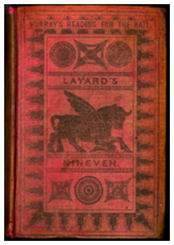Excavations begin
Claudius Rich's work in 1820s served as inspiration for the next generation of European explorers. The French sent Paul Emile Botta, a doctor and naturalist who in 1842 had been appointed consul at Mosul. He found relatively little at Nineveh. In 1843 he investigated reports that large carved stones had been found at Khorsabad, and moved his operations there instead. In 1847 the first Assyrian reliefs reached the Louvre; these were the first to reach any European museum. Botta's 1850 publication of excavations at the palace amazed the nation. But the local authorities and the Turkish government were suspicious of European motives, fearing treasure hunting and perhaps political or military interference.

A print showing Paul Emile Botta, pioneer excavator in Assyria. Private collection
Another important character inspired by Rich, and a visitor and friend of Botta, was Austen Henry Layard. He spent several years travelling in the Middle East, and living with local groups. Then Sir Stratford Canning, British ambassador in Constantinople, provided Layard with the finances to begin excavations. He excavated at Nineveh and Nimrud between 1845 and 1851. Sometime between March and May 1850 the first large group of Library tablets was found, in Rooms 40 and 41 of the SWP at Kuyunjik. Layard was at the time away in the Khabur. His supervisor, Toma Shishman ("Fat Toma"), led the excavations in his absence. In his popular publication, Layard (1853) pp. 344-347 relays the discovery as follows:

A contemporary print illustrating the room where many of the first Library tablets were found. Published in Layard (1853). Private collection
I shall call these chambers "the chambers of records," or, like "the house of the rolls," or records, which Darius ordered to be searched for the decree of Cyrus, concerning the building of the temple of Jerusalem, they appear to have contained the decrees of the Assyrian kings as well as the archives of the empire.
... The chambers I am describing appear to have been a depository in the palace of Nineveh for such documents. To the height of a foot or more from the floor they were entirely filled with them; some entire, but the greater part broken into many fragments, probably by the falling in of the upper part of the building. They were of different seizes; the largest tablets were flat, and measured about 9 inches by 6½ inches; the smaller were slightly convex, and some were not more than an inch long, with but one or two lines of writing. The cuneiform characters on most of them were singularly sharp and well defined, but so minute in some instances as to be almost illegible without a magnifying glass.
... The adjoining chambers contained similar relics, but in far smaller numbers. Many cases were filled with these tablets before I left Assyria, and a vast number of them have been found, I understand, since my departure. A large collection of them is already deposited in the British Museum.

Toma Shishman, foreman at Nineveh during Layard's excavations. Copyright Trustees of the British Museum. CC BY-NC-SA 4.0 [https://www.britishmuseum.org/terms-use/copyright-and-permissions]
Reade (2000) p. 421 calculated the volume taken up by the tablets according to this description. He noted that it must be an exaggeration, since it exceeds the space now taken up by them in the museum. There is no good reason to doubt that the gist of the description is true, however. It is entirely plausible that the tablets were spread throughout the rooms, not concentrated in small areas. And it is plausible that in places the height of the deposit could have exceeded a foot or more. If mixed with rubble from the destruction of the palace – note that most of the tablets are broken – it is quite possible that the space taken up by them could indeed have exceeded that of their modern museum storage. In any case it is clear that this was a massive find of tablets. Thousands more were found in these same rooms by George Smith in 1874 and in the spoil heaps from those rooms by Wallis Budge 1890–91. Further large finds were made around Rooms 40-41 and in and outside the southwest sector of the palace. Layard's hope was to publish affordably so as to reach as wide an audience as possible. His book A Popular Account of Discoveries at Nineveh proved incredibly popular.

Layard's best selling book, A Popular Account of Discoveries at Nineveh. Private collection
In late 1853 Hormuzd Rassam was excavating at the North Palace on Kuyunjik. He found there a second large group of tablets from Ashurbanipal's collection. Over the next 100 years the British Museum conducted a series of campaigns to recover more of the Library. A second round of public excitement accompanied George Smith's expeditions in 1870's. A third followed in the 1920's-30's, with Campbell Thompson's scientific excavations. Iraqi teams took over in 1950's-80's, joined by British and American colleagues in 1980's. The task of recovering the Library is still not complete. Recent Iraqi excavations have been looking for some of the remaining tablets.
Jonathan Taylor
Jonathan Taylor, 'Excavations begin', Ashurbanipal Library Project, The Ashurbanipal Library Project, Department of the Middle East, The British Museum, Great Russell Street, London WC1B 3DG, 2022 [http://oracc.museum.upenn.edu/asbp/archaeologyofthelibrary/excavations/]